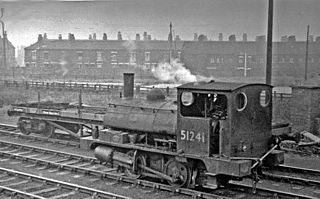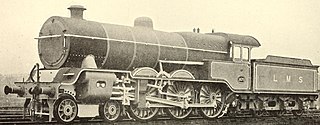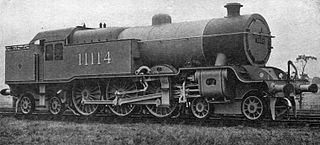George Hughes was an English locomotive engineer, and chief mechanical engineer of the Lancashire and Yorkshire Railway ( ) and the London, Midland and Scottish Railway (LMS).

Sir John Audley Frederick Aspinall was an English mechanical engineer who served as Locomotive Superintendent of the Great Southern and Western Railway (GS&WR) of Ireland and Lancashire and Yorkshire Railway (L&YR) of England. He introduced vacuum brakes to his locomotives in Ireland, a trend which was followed in Britain, and designed several locomotives. He was also president of the Institution of Mechanical Engineers and of the Institution of Civil Engineers.
Henry Albert Hoy (1855–1910) was a locomotive engineer with the Lancashire and Yorkshire Railway (L&YR). Hoy was born on 13 January 1855 in London, and educated at King Edward VI's Grammar School in St Albans, and at St John's College, Liverpool University.
Hewitt Pearson Montague Beames was Chief Mechanical Engineer of the London and North Western Railway from 1920 to 1922.
Locomotives of the Lancashire and Yorkshire Railway. The Lancashire and Yorkshire Railway locomotive works were originally at Miles Platting, Manchester. From 1889 they were at Horwich.

Wigan Wallgate railway station is one of two railway stations serving the town centre of Wigan in Greater Manchester, England. The station serves two routes, the Manchester-Southport Line and the Manchester-Kirkby Line. It is 16 miles north-west of Manchester Victoria. The station is managed by Northern, who operate all trains serving it.

The Lancashire and Yorkshire Railway Class 5 were 2-4-2T steam locomotives designed by Chief Mechanical Engineer (CME) John Aspinall and introduced from 1889 for local passenger work. Later batches included progressive modifications such as extended coal bunkers and belpaire fireboxes. The final batch built from 1911 to 1914 under George Hughes incorporating superheated boilers and belpaire firebox gave increased tractive effort, others were also rebuilt to this standard. When Hughes introduced his classification system in 1919 the more powerful superheated superheated locomotives were designated Class 6. The final examples were withdrawn in 1961.

The L&YR Class 21 is a class of small 0-4-0ST steam locomotive built by the Lancashire and Yorkshire Railway for shunting duties. They were nicknamed Pugs.

The Lancashire and Yorkshire Railway Class 27 is a class of 0-6-0 steam locomotive designed for freight work on the Lancashire and Yorkshire Railway (L&YR).

The Lancashire and Yorkshire Railway Class 28 was a class of 0-6-0 steam locomotive, designed by George Hughes for the Lancashire and Yorkshire Railway (L&YR). It was a rebuild of Aspinall's Class 27, with the addition of a Belpaire firebox and the extension of the footplate and front sandboxes. It was similar, but had larger cylinders and a superheater. It had 5-foot-1-inch (1.549 m) wheels.

The Lancashire and Yorkshire Railway (L&YR) class 8 was a four-cylinder 4-6-0 express passenger locomotive designed by George Hughes introduced in 1908.

The Lancashire and Yorkshire RailwayHughes 4-6-4T was a class of steam locomotives. They were a 4-6-4T tank engine version of the L&YR Class 8, hence they were known as "Dreadnought tanks".
The Lancashire and Yorkshire Railway (L&YR) operated two classes of twenty steam railmotors in total.

The Lancashire and Yorkshire Railway Class 32 was a small class of 0-8-2T steam locomotives, intended for heavy shunting and banking duties.

The L&YR Class 31 was a class of 0-8-0 steam locomotives of the Lancashire and Yorkshire Railway. The class was designed by George Hughes and introduced in 1912. The class comprised 115 new locomotives and 40 rebuilt from other classes.

The L&YR Class 30 was a class of 0-8-0 steam locomotives of the Lancashire and Yorkshire Railway, designed by George Hughes. The prototype was rebuilt from an Aspinall Class 30 locomotive in 1904. Ten new locomotives were built in 1907. The locomotives passed to the London, Midland and Scottish Railway (LMS) in 1923.

The L&YR Class 30 (Hughes) was a class of 0-8-0 steam locomotives of the Lancashire and Yorkshire Railway. The class was designed by George Hughes and introduced in 1910. Twenty-nine were rebuilds from Aspinall's L&YR Class 30 and 40 were new locomotives.
The L&YR Class 2 (Aspinall) was a class of 4-4-0 steam locomotives of the Lancashire and Yorkshire Railway.
The L&YR Class 3 was a class of 4-4-0 steam locomotives of the Lancashire and Yorkshire Railway introduced in 1891 with forty being built. George Hughes rebuilt six locomotives with superheaters between 1908 and 1909, they were later designated L&YR Class 4. All passed to the London, Midland and Scottish Railway at the grouping in 1923 but were withdrawn by 1930.
The L&YR 2-10-0 was a prospective design for a class of 2-10-0 steam locomotives on the Lancashire and Yorkshire Railway. Initial designs were made by George Hughes between 1913–1914, but none of the class were built. If they had been, these would have been the UK's first 10-coupled locomotives in regular service.
This page is based on this
Wikipedia article Text is available under the
CC BY-SA 4.0 license; additional terms may apply.
Images, videos and audio are available under their respective licenses.











